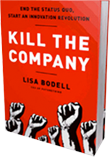Kill the Company by Lisa Bodell. Bibliomotion, 2012. 237 + xv pages. US$27.95.

Most engineers work in firms where a degree of innovation is demanded for successful business growth. Lisa Bodell's new book, Kill the Company, offers an entertaining and contrarian view to shake up the status quo and bring about change.
Kill the Company describes three typical organizational cultures we encounter today: a positive culture, a negative culture, and a complacent culture. Positive innovation cultures (think Google) encourage smart risks and challenge employees to bring forth creative ideas. Negative cultures begin a downward slide by taking no risks and losing ground to competitors. Negative cultures are staffed with professional skeptics and devils' advocates. They are characterized by too many and ineffective meetings. Yet, a negative culture still can favor creativity with an "innovate or die" mindset.
Ms. Bodell indicates the worst culture is the complacent culture. These organizations are staffed with generally happy employees who like their jobs. Firms with complacent cultures are taking advantage of short-term growth opportunities and are not facing immediate competitive threats. Yet, this complacency is just what kills innovation.
Two killer tools for innovation
Innovation is inextricably linked with organizational change. Two outstanding tools introduced in this book are Kill the Company and Kill a Stupid Rule. In the first exercise, employees use their inside knowledge and apply an outside view to imagine how they would put their own company out of business. This creative exercise is liberating for team members and helps detail a list of realistic competitive threats.
Kill a Stupid Rule recognizes that many rules, procedures, and policies can become not only annoying over time, but also serve as barriers to engineers working effectively. In this exercise, managers take immediate action to eliminate bulky approval forms, unnecessary reports, lengthy expense statements, and/or unproductive meetings. Engineers and other staff members are instantly granted more time to do their real work and to performing their jobs. Moreover, management demonstrates a commitment to real and lasting organizational change.
A case study of change management accompanied by increased innovation is detailed in one chapter, while closing chapter offers a full descriptions of each innovation tool. The innovation tools come with suggestions on when to use the exercise, with whom, and how to implement them.
Kill the Company is a good book for anyone trying to accomplish organizational change. Engineers are often boxed in by rules and procedure, yet thinking creatively can allow us to see new opportunities.


